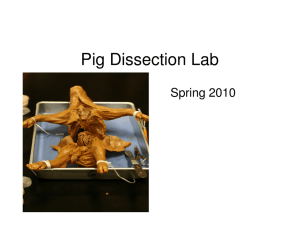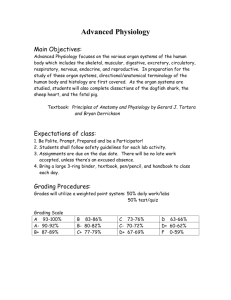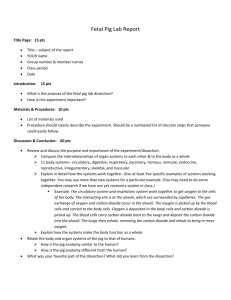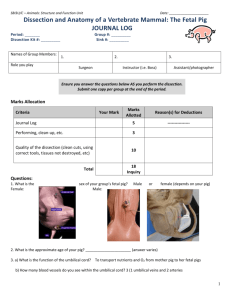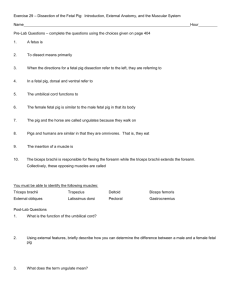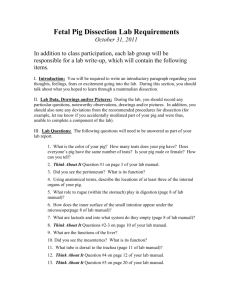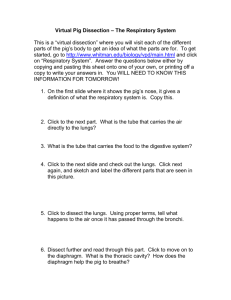SBI3U – Animals: Structure and Function Unit
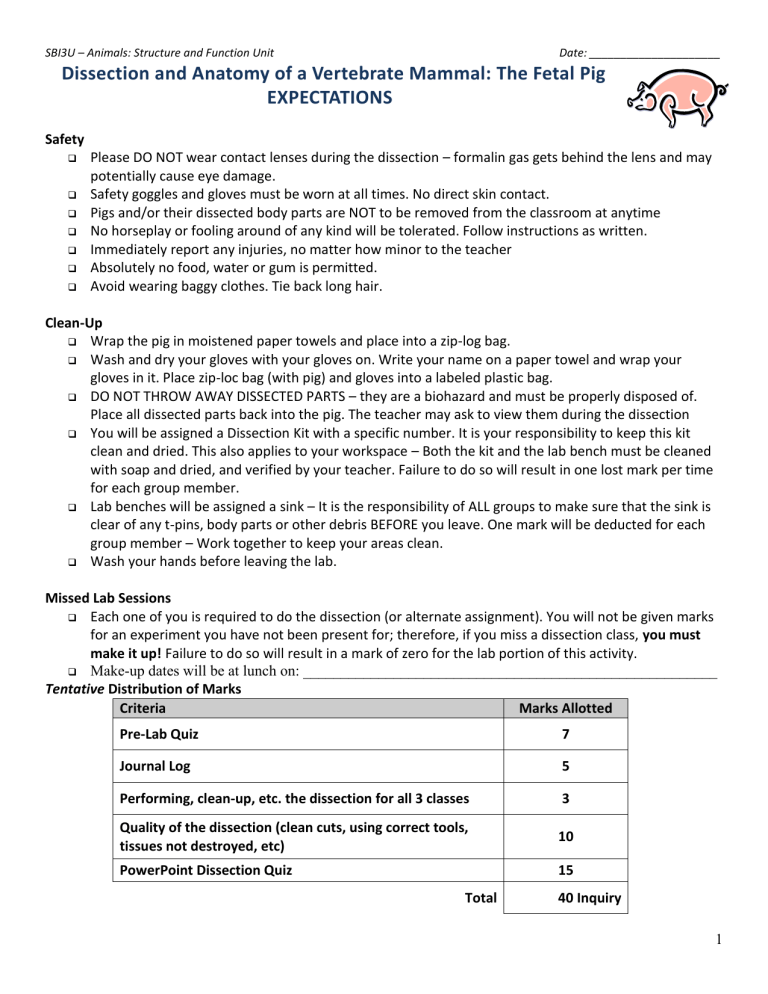
SBI3U – Animals: Structure and Function Unit Date: _____________________
Dissection and Anatomy of a Vertebrate Mammal: The Fetal Pig
EXPECTATIONS
Safety
Please DO NOT wear contact lenses during the dissection – formalin gas gets behind the lens and may potentially cause eye damage.
Safety goggles and gloves must be worn at all times. No direct skin contact.
Pigs and/or their dissected body parts are NOT to be removed from the classroom at anytime
No horseplay or fooling around of any kind will be tolerated. Follow instructions as written.
Immediately report any injuries, no matter how minor to the teacher
Absolutely no food, water or gum is permitted.
Avoid wearing baggy clothes. Tie back long hair.
Clean-Up
Wrap the pig in moistened paper towels and place into a zip-log bag.
Wash and dry your gloves with your gloves on. Write your name on a paper towel and wrap your
gloves in it. Place zip-loc bag (with pig) and gloves into a labeled plastic bag.
DO NOT THROW AWAY DISSECTED PARTS – they are a biohazard and must be properly disposed of.
Place all dissected parts back into the pig. The teacher may ask to view them during the dissection
You will be assigned a Dissection Kit with a specific number. It is your responsibility to keep this kit
clean and dried. This also applies to your workspace – Both the kit and the lab bench must be cleaned with soap and dried, and verified by your teacher. Failure to do so will result in one lost mark per time for each group member.
Lab benches will be assigned a sink – It is the responsibility of ALL groups to make sure that the sink is clear of any t-pins, body parts or other debris BEFORE you leave. One mark will be deducted for each group member – Work together to keep your areas clean.
Wash your hands before leaving the lab.
Missed Lab Sessions
Each one of you is required to do the dissection (or alternate assignment). You will not be given marks for an experiment you have not been present for; therefore, if you miss a dissection class, you must
make it up! Failure to do so will result in a mark of zero for the lab portion of this activity.
Make-up dates will be at lunch on: _______________________________________________________
Tentative Distribution of Marks
Criteria Marks Allotted
Pre-Lab Quiz 7
Journal Log
Performing, clean-up, etc. the dissection for all 3 classes
Quality of the dissection (clean cuts, using correct tools, tissues not destroyed, etc)
PowerPoint Dissection Quiz
Total
5
3
10
15
40 Inquiry
1
Dissection Pre-Lab Questions
1. What is the purpose of this dissection?
2. What 2 pieces of safety equipment must you wear at all times during the dissections?
3, If the preservatives touches your skin, what should you do immediately?
4. Why should you wash your hands, wipe down the lab bench and make sure all tools are scrupulously clean and dry after dissection?
5. Before you attach the pig to the tray what are you supposed to do according to the instructions? (be specific)
6. How are you to attach the pig to the dissection tray?
7. What instrument must you use for your first cut? Why?
8. Which portion of the body will you be working on first?
9. What must you do, if you are injured during this lab (even if you have a paper cut)?
10. What should you do if you finish early?
2
SBI3U – Animals: Structure and Function Date: _____________________________
Fetal Pig Dissection
Adapted from Biology 11, R. Bowers et al, Addison-Wesley, 2002
Animals used for scientific research and dissection help us to understand our own bodies and how they function in health and disease. The fetal pig will be used as a representative mammal. As a fetus, the pig receives nutrients and oxygen from its mother through the umbilical cord. Read the safety and dissection directions carefully.
Purpose:
To study the external and internal anatomy of the fetal pig to gain perspectives on the following:
relative positions and sizes of organs
interrelations between organs and organ systems
scientific process of dissection and its applications for anatomy and physiology.
IMPORTANT:
Please read through the expectations and safety guidelines located AT THE FRONT OF THIS PACKAGE before conducting the dissection
Materials:
safety goggles
non-latex gloves
preserved fetal pig
antibacterial soap
scalpel
ruler
clear bag
dissecting pins
dissecting tray
string
scissors
dissecting microscope
blunt probe
paper towel
Table 1: Relationship of fetal Pig Length to Age in Utero
Procedure:
Part 1: External Anatomy
Length of String (cm) Age of Pig (in days)
1. The fetal pig has four main body segments: the head, neck, trunk, and tail. You will also be able to identify four appendages and an umbilical cord.
2. Use the string to measure your pig from the tip of its snout to the base of its tail. Lay the pig flat on the dissection tray and stretch the string between the nose and the tail. Measure the section of string against a ruler and match your measurement in Table 1 to determine the age of your pig.
0-10
10-20
20-30
40-50
100
150
200
300
20
30-35
45-50
55
70
80
100
120
3. Place the fetal pig on its back (dorsal surface) and locate the pairs of nipples along the ventral surface. Both male and female fetal, pigs have these nipples. Notice the umbilical cord. What is the function of the umbilical cord? How many blood vessels do you see within the
umbilical cord?
4. Use the diagrams to determine the sex of your pig. In females, the urogenital opening is located slightly ventral to the anus. A small, spiked tissue often called the genital papilla projects from the urogenital opening. See Figure 2 (a). In males, the scrotum containing the testes can be located just ventral to the anus. The urogenital
Figure 1: Body segments and planes of section in a fetal pig opening of the male is found immediately posterior to the umbilical cord. See Figure 2 (b). What is the sex of your pig?
3
Figure 2: a) Female pig b) male pig
5. Examine the feet of the fetal pig. Indicate the position and the number of toes.
6. Examine the head of your fetal pig. The flaps of skin surrounding the ear are called pinnae. The fetal pig has a snout and nostrils. Examine the chin of your fetal pig. Do you notice any hair? Does your fetal pig have eyelashes? Does your fetal pig have a tongue?
Part 2: Internal Anatomy
Abdominal Cavity and the Organs of Digestion
You will be directed to examine various organs as they become visible. It is important to follow the directions carefully and to only remove those organs that you are specifically asked to remove. Proceed carefully. One simple technique to ensure that you do not make any wrong incisions is to make superficial incisions first and then to follow those with deeper incisions.
7. Exposing the ventral surface: With the pig still on its dorsal surface, attach one piece of string to each of the pig’s ankles and another to its opposite wrist. Pull the strings from an opposing wrist and ankle under the dissecting pan and tie. Repeat the procedure for the other wrist and pull again to explore the ventral surface. (See Figure 3.)
To effectively expose the inner organs of your fetal pig, make five incisions.
The first incision — cutting the ventral surface: (Hint: because the pig may be rubbery from being preserved, sharp dissecting scissors are better than a scalpel for this incision.) Make a 10-15 cm incision just in front of the umbilical cord and cut toward the head. Follow incision 1 in Figure 3. Sketch the incision first using a black marker on the surface of the fetal pig. This will ensure the accuracy of your incisions.
The second incision — cutting toward the posterior surface. Use a scalpel to make an incision toward the posterior of the pig. Follow incision 2 in Figure 3.
The third incision — cutting toward the lateral surface. Use scissors to make lateral incisions following incision 3 in
Figure 3.
The fourth incision — cutting toward the posterior portion of the abdominal cavity. Use a scalpel to make incisions following incision 4 in Figure 3.
The fifth incision — cuffing between the thoracic and abdominal cavities. Use scissors to make an incision starting at the midline, and extend the incision laterally on both sides of the pig. Follow incision 5 in Figure 3. This incision runs parallel to the diaphragm and separates the thoracic and abdominal cavities. Hint: You may want to feel for the ribs
while making this incision.
4
Figure 3: Incisions for dissection of a fetal pig Figure 4: The organs of digestion
8. Exposing the abdominal cavity: pulling apart the flaps at incision 5 best exposes the abdominal cavity. Notice the layer of connective tissue called the peritoneum that holds the abdominal organs in place. You may need to tease this layer away before staffing your detailed examination of the internal organs. The posterior portion of the abdominal cavity is best viewed when the flaps on incision 4 are pulled apart and secured by pins. Refer to Figure 4 for the digestive organs.
9. Locating the liver and the gallbladder: The liver is easily seen in the anterior aspect of the abdominal cavity. The gallbladder is located underneath the liver. Identify the gallbladder. Look carefully to see the thin duct that connects the gallbladder to the small intestine. The liver appears a dark red or brown colour, because it is engorged with blood. The liver contains 20% of the total blood supply in the fetal pig’s body at any given time. Which portion of the small intestine does the gallbladder connect to?
10. Locating the stomach: Beneath the liver, on the left side of the fetal pig, is the stomach, which is normally a hollow organ. The anterior portion of the stomach is joined to the esophagus. The posterior junction is attached to the first part of the small intestine, called the duodenum. With your dissection tool, try to lift the small intestine. What do you notice?
A thin, transparent film covers the small intestine. This is called the mesentery. This film or layer of connective tissue is around other organs. What is the advantage of having such a film? Observe the blood vessels running in the mesentery.
11. Locating the pancreas: The pancreas is located toward the back wall of the abdominal cavity. It is a finger-shaped gland that is typically creamy white in colour. It is best reached by lifting the junction between the stomach and the small intestine. As an accessory organ in digestion, what vital substances does the pancreas provide?
12. Locating the spleen: Look toward the left side of the fetal pig to see the spleen, found near the outer curvature of the stomach. What is its function?
13. Remove the stomach by cuts at the junctions with the esophagus and the small intestine. Cut along the midline of the stomach, rinse the stomach with water, and examine it under the dissecting microscope. Observe the lining of the stomach. What do you notice?
14. Locating the small and large intestines: Carefully use your scissors to snip away the mesentery tissue. Unravel the small intestine. Locate the large intestine and compare its structure and length with those of the small intestine. How is the small intestine different from the large intestine? How long is your pig’s small intestine?
5
Thoracic Cavity and the Organs of Respiration and Circulation
15. Exposing the thoracic cavity: Using dissecting pins, fold back and pin the flaps of skin that cover the thoracic cavity.
The thoracic cavity is the area between incisions 3 and 5. Refer to Figure 5 for the heart and major blood vessels.
16. Locating the heart: The heart is found between the two lungs and is protected by the rib cage. In the adult human, gaining access to the heart is very difficult, and involves the sawing of the sternum and spreading of the ribs. In the fetal pig, one does not need much force to access the heart. In fact, simple scissors are enough for this task. Can you explain this?
Figure 5: Ventral View of heart and major blood vessels in the fetal pig
A thin and transparent film called the pericardium, similar to the mesentery of the small intestine, surrounds the heart.
Remove the pericardial membrane that encases the heart. Why might forceps be the best tool to accomplish this?
17. Locating each of the major vessels of the heart.
inferior vena cava: runs from the liver and lower part of the body to the right side of the heart; empties into the right atrium.
superior vena cava: runs from the upper body of the pig to the right side of the heart; empties into the right atrium.
pulmonary trunk: starts at the right ventricle; transports deoxygenated blood to the lungs
aorta: the largest artery in the circulatory system; starts at the left ventricle; branches to transport blood to all major organs. Passes through the thoracic and abdominal cavities.
aortic arch: the part of the aorta that arises from the left ventricle. Two major vessels come from the aortic arch; the brachiocephalic trunk splits to send vessels to the right forelimb and the head, the left subclavian artery supplies the left forelimb.
18. Discovering the four chambers of the heart. Using your blunt probe, locate the right atrium. Deoxygenated blood from the body enters the heart here. Separate the inferior and superior venae cavae from the right atrium using scissors.
Locate the left atrium and notice that several vessels enter it. These are the pulmonary veins from the lungs. Separate the pulmonary veins from the heart using scissors.
Find the aorta coming off the left ventricle and separate it from the heart using scissors.
Find the pulmonary trunk arising from the right ventricle and separate it from the heart using scissors.
6
Review the flow of blood through the heart. The pulmonary circulation begins at the right atrium; blood flows to the right ventricle, pulmonary trunk and pulmonary arteries and then to the lungs. The blood returns to the left atrium by way of the pulmonary veins. The systemic circulation begins at the left atrium; blood flows to the left ventricle, aorta, and to all systems of the body. Blood returns to the heart by way of the superior and inferior venae cavae, which enter the heart at the right atrium.
Remove the heart from the thoracic cavity. You may need to tease away any connective tissue. Hold the heart in your hand and orient it, as it would appear in the fetal pig. Note the large vessel that traverses the ventral surface of the heart. This is the coronary artery and it provides oxygenated blood to the heart itself.
19. The dorsal surface of the heart. Turn the heart over and observe the dorsal surface. Refer to Figure 6 and observe the entry of the venae cavae and pulmonary veins into the right and left atria.
20. Dissection of the heart: Make an incision that separates the left side from the right side of the heart. Note the inner walls of the heart and their texture. Look at the thickness of the left and right ventricles. Compare the size of the wall of a ventricle and an atrium. What do you notice?
21. Locating the lungs: The lungs are closely associated with the heart. They oxygenate the blood received from the right Figure 6: Dorsal view of the heart in the fetal pig ventricle via the pulmonary arteries, and deliver oxygenated blood back to the left atrium via the pulmonary veins. The lungs are relatively large because the bronchial tree is contained within them. Do you notice any difference in the size of the two lungs?
20. Make a lateral incision across the heart and explore the heart chamber. Compare the size of the wall of a ventricle with that of an atrium. Why does the left ventricle contain more muscle than the right ventricle?
21. Locate the spongy lungs on either side of the heart and the trachea leading into the lungs. Why do the lungs feel spongy?
22. Place your index finger on the trachea and push downward. Describe what happens. What function do the cartilage
rings of the trachea serve? Where is the esophagus in relation to the trachea? Open up the neck to expose the larynx.
7
SBI3U – Animals: Structure and Function Unit Date: _____________________
Dissection and Anatomy of a Vertebrate Mammal: The Fetal Pig
JOURNAL LOG
8
Period: _______ Group #: _________
Names of Group Members:
Dissection Kit #: _________ Sink #: _________
1. 2. 3.
Marks Allocation
Ensure you answer the questions below as you perform the dissection.
Submit one copy per group at the end of each period.
Criteria
Journal Log
Performing, clean-up, etc. the dissection for all 3 classes
Your Mark
Marks
Allotted
5
3
Reason(s) for Deductions
----------------
Quality of the dissection (clean cuts, using correct tools, tissues not destroyed, etc)
10
Total
18
Inquiry
Questions:
1. What is the sex of your group’s fetal pig? Male or female
2. What is the approximate age of your pig? ______________________
3. a) What is the function of the umbilical cord?
b) How many blood vessels do you see within the umbilical cord? _________________
4. a) Do you notice any hair? Yes or No
b) Does your fetal pig have eyelashes? Yes or No
c) Does your fetal pig have a tongue? Yes or No
5. Which portion of the small intestine does the gallbladder connect to? _____________________________________
6. What is the advantage of having such a film (mesentery)?
7. As an accessory organ in digestion, what vital substances does the pancreas provide?
8. What is the function of the spleen?
9
9. What do you notice when you observe the inner lining of the stomach under the dissecting microscope?
10. a) How is the small intestine different from the large intestine? b) What is the length of the unraveled small intestine? ______________
11. What do you notice between the sizes of the walls of the atria and the ventricles?
12. Do you notice any difference in the size of the two lungs? Explain.
13. Why does the left ventricle contain more muscle than the right ventricle?
14. Why do the lungs feel spongy?
15. What function do the cartilage rings of the trachea serve?
16. Where is the esophagus in relation to the trachea?
10
SBI3U – Animals: Structure and Function Unit Name: ________________________________________________
Fetal Pig Dissection Alternative Assignment
During the course of the three-day dissection you will sign in with me first to acknowledge your presence and then you will proceed to the library to complete the virtual pig dissection.
Part A – Virtual Pig Dissection
To access the virtual pig dissection: Go to http://www.whitman.edu/content/virtualpig . Use the manual and ensure you are able to know the structures mentioned in the various steps.
You will be responsible to report to write the Dissection PowerPoint Quiz with your classmates on Fri. March
17 th .
Part B – Essay (18 marks)
Write a 500-word essay on the pros and cons of dissection. Use references from the Internet. The third part of the essay you will state your opinion and why you have that opinion of dissection. Please be clear in your thought processes and in your reasons why. Back up your opinion with concrete references.
A proper bibliography in APA format needs to be attached to your essay. At least three references are required.
You may use your computer time in the library to complete the essay.
The Essay is due by ________________________________________.
Marks Allocation
Criteria Your Mark
Marks
Allotted
Pre-Lab Quiz 7
Journal Log
Essay (w/bibliography)
3
15
Dissection Lab Quiz
Total
15
40
Inquiry
11
SBI3U – Animals: Structure and Function Unit Date: _____________________
Dissection and Anatomy of a Vertebrate Mammal: The Fetal Pig
JOURNAL LOG – Alternative Assignment
Period: _______ Name: ________________________________________
Ensure you answer the questions below as you perform the virtual dissection.
Submit your copy at the end of each period.
Questions:
1. a) What is the function of the umbilical cord?
b) How many blood vessels do you see within the umbilical cord? _________________
2. a) Do you notice any hair? Yes or No
b) Does your fetal pig have eyelashes? Yes or No
c) Does your fetal pig have a tongue? Yes or No
3. Which portion of the small intestine does the gallbladder connect to? _____________________________________
4. What is the advantage of having such a film (mesentery)?
5. As an accessory organ in digestion, what vital substances does the pancreas provide?
6. What is the function of the spleen?
7. How is the small intestine different from the large intestine?
8. What do you notice between the sizes of the walls of the atria and the ventricles?
9. Do you notice any difference in the size of the two lungs? Explain.
12
10. Why does the left ventricle contain more muscle than the right ventricle?
11. What function do the cartilage rings of the trachea serve?
12. Where is the esophagus in relation to the trachea?
13
Period: ____
A
____
Group
Jeremy
1:
Katarina
MS. PHAM’S CLASS DISSECTION GROUP ALLOCATION
Group
6:
Addie
Nathaniel
Lauren
Caroline
Group
2:
Alison
Mark
Hayley
Group
3:
Brandon
Sololia
Artiom
Group
4:
Andrei
Arman
Dante
Group
5:
Jamie
Erin
Graeme
Group
11:
Group
7:
Group
8:
Group
9:
Group
10:
Nara
Drew
Olivier
Trae
Anton
Jennifer
Read
Huu-Khang
Anastasios
14
1 6
2 7
3 8
4 9
5 11
15

